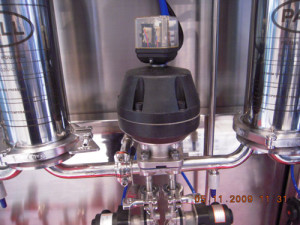SIP of a freeze dryer essentially follows the principles of an autoclave when steam is used as the sterilant. SIP with steam is the most popular method to achieve sterility assurance inside the entire freeze dryer prior to loading product in open containers into the system. The system follows a similar process as a vacuum type autoclave with many differences! The objective of this process is to have the sterilant reach the entire interior of the dryer, raising the pressure and the temperature sufficiently to kill even spores of any microorganisms present, and to retain the sterility until product is dry and removed from the system. The temperature is about 123 degrees Centigrade, and the pressure above 15 psig during the whole process. The process starts with a vacuum [produced by a liquid ring vacuum pump] whereupon the automatic locking chamber door and slot door are sealed and locked. The pressure is increased by admitting steam until the pressure and temperature increases, whereupon the system is evacuated and heated several more times. When this pulsing is completed, air is purged from the system, and the system is then pressurized to a holding pressure and temperature in excess of 121 degrees Centigrade, for sufficient time to inactivate thermophilic biological indicators. Then the doors are unlocked, and the system force cooled and pressurized with sterile gas or air so that product loading can occur. SIP is carried out between every cycle. The chamber and condenser and any internal surface bound by the first valve is subjected to the effects of the sterilant. The cycle proceeds automatically, and during the process the vacuum release filter or filters are sterilized and dried, and the chamber including the chamber door[s] cooled rapidly using water jackets and water from cooling towers, or recirculated heat transfer fluid from the freeze drying heat transfer system. SIP follows CIP. Both are validated processes.

